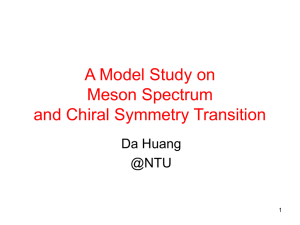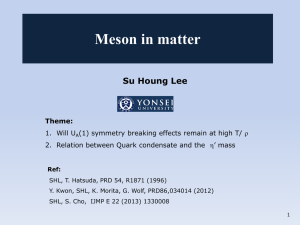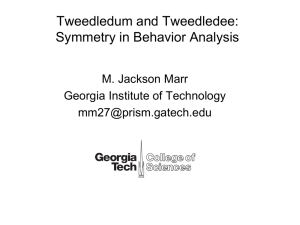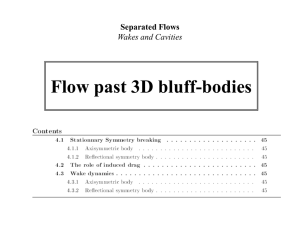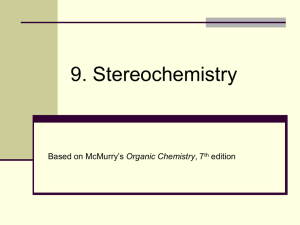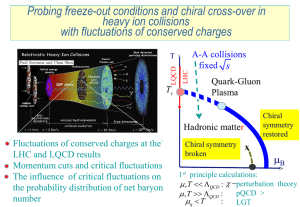Chiral Symmetry Breaking
advertisement
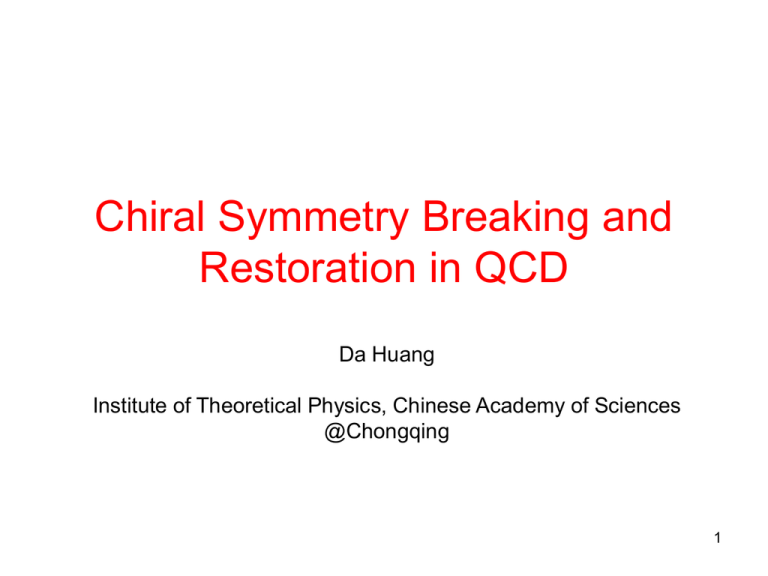
Chiral Symmetry Breaking and Restoration in QCD Da Huang Institute of Theoretical Physics, Chinese Academy of Sciences @Chongqing 1 Content • Dynamically Generated Spontaneous Chiral Symmetry Breaking In Chiral Dynamical Model At Zero Temperature • Chiral Thermodynamic Model of QCD and its Critical Behavior 2 Dynamically Generated Spontaneous Chiral Symmetry Breaking In Chiral Dynamical Model At Zero Temperature 3 QCD Lagrangian and Symmetry Chiral limit: Taking vanishing quark masses mq→ 0. QCD Lagrangian L (o ) QCD q L iD q L q R iD q R D g s / 2 G u q d s q R ,L 1 2 1 4 G G (1 5 ) q has maximum global Chiral symmetry : SU L ( 3 ) SU R ( 3 ) U A (1) U B (1) 4 The Problem However, in the low-energy meson spectrum, we have not seen such symmetry patterns. The natural question is how these (exact or approximate) symmetries are broken (explicitly or spontaneously)? 5 QCD Lagrangian and Symmetry • QCD Lagrangian with massive light quarks 6 Effective Lagrangian Based on Loop Regularization Y.B. Dai and Y-L. Wu, Euro. Phys. J. C 39 s1 (2004) Note that the field Φ has no kinetic terms, so it is an auxiliary field and can be integrated out. 7 Dynamically Generated Spontaneous Symmetry Breaking Instead, if we integrate out the quark fields, we can obtain the following effective potential. 8 Dynamically Generated Spontaneous Symmetry Breaking Recall that the pseudoscalar mesons, such as π,η, are much lighter than their scalar chiral partners. This indicates that we should choose our vacuum expectation values (VEVs) in the scalar fields: 9 Dynamically Generated Spontaneous Symmetry Breaking By differentiating the effective potential w.r.t. the VEVs, we obtain the following Minimal Conditions/Generalized Gap Equations: If we take the limit of vanishing instanton effects, we can recover the usual gap equation 10 Composite Higgs Fields Low Ener gy Dynam ics Of QCD q Dynamically Generated Higgs Potential For Scalar Mesons q qL qR g V() = - 2 2 + 4 q q Spont aneous Sym m et ry Breaking quark Pseudoscalar is Goldst one Scalar f ield is Higgs Mesons 11 Scalars as Partner of Pseudoscalars According to their quantum numbers, we can reorganize the mesons into a matrix form. Scalar mesons: Pseudoscalar mesons : 12 Mass Formula Pseudoscalar mesons : Instanton interactions only affect mass of SU(3) singlet 13 Mass Formula 14 Predictions for Mass Spectra & Mixings 15 Predictions 16 Chiral Symmetry Breaking -- Answer to Our Primary Question Chiral SUL(3)XSUR(3) spontaneously broken Goldstone mesons π0, η8 Chiral UL(1)XUR(1) breaking Instanton Effect of anomaly Mass of η0 Flavor SU(3) breaking The mixing of π0, η and η׳ 17 Chiral Thermodynamic Model of QCD and its Critical Behavior 18 Motivation Provided that chiral dynamical model works so well to show chiral symmetry breaking and to predict the meson spectrum, we want to see what happens for this model at finite temperature -- Chiral symmetry will be restored at high enough temperature 19 Effective Lagrangian by DH, Y-L Wu, 1110.4491 [hep-ph] 20 Dynamically Generated Spontaneous Symmetry Breaking By integrating out the quark fields with Closed Time Path (CTP) formalism, we obtain the following effective potential at finite temperature 21 Dynamically Generated Spontaneous Symmetry Breaking 22 Dynamically Generated Spontaneous Symmetry Breaking Recall that the pseudoscalar mesons, such as π,η, are much lighter than their scalar chiral partners. This indicates that we should choose our vacuum expectation values (VEVs) in the scalar fields: 23 Dynamically Generated Spontaneous Symmetry Breaking By differentiating the effective potential with respect to the VEVs, we can obtain: After we take the limit of zero current quark masses, the gap equation can be simplified to 24 Critical Temperature For Chiral Symmetry Restoration In order to determine the critical temperature for chiral symmetry restoration, we need to make the following assumption: Note that μf 2 (T) is the coupling of the four quark interaction in our model. In principle this interaction comes by integrating out the gluon fields. Thus, this assumption indicates that the low energy gluon dynamics have the same finite temperature dependence as the quark field. 25 Critical Temperature For Chiral Symmetry Restoration With the above assumption, we can determine the critical temperature for chiral symmetry restoration in the chiral thermodynamic model (CTDM) 26 Scalars as Partner of Pseudoscalars & Lightest Composite Higgs Bosons Scalar mesons: Pseudoscalar mesons : 27 Mass Formula Pseudoscalar mesons : Scalar mesons (Lightest Composite Higgs Boson) : 28 Predictions for Mass Spectra 29 Chiral Symmetry Restoration at Finite Temperature Vacuum Expectation Value (VEV) 30 Chiral Symmetry Restoration at Finite Temperature Pion Decay Constant 31 Chiral Symmetry Restoration at Finite Temperature Quark Condensate 32 Chiral Symmetry Restoration at Finite Temperature Mass for Pseudoscalar mesons 33 Chiral Symmetry Restoration at Finite Temperature All of these quantities have the same scaling behavior near the critical temperature, This feature can be traced back to the fact that all of these quantities are proportional to the VEV near the critical temperature 34 Summary and Outlook • In the simple chiral dynamical model, Prof. Dai and Prof. Wu derived a consistent spectrum of lowest lying meson states. • Within this model, we discuss the chiral symmetry restoration at finite temperature by determining the critical temperature and critical behavior of some characteristic quantities. • In the future work, we need to consider finite chemical potential effects. Also, we also want to extend the current work into three flavor case and consider instanton finite 35 temperature effects. THANKS 36 Back up 37 Dynamically Generated Spontaneous Symmetry Breaking 38
